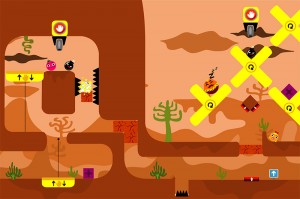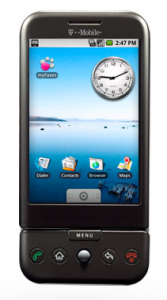 Touch Arcade recently had the opportunity to conduct a half-hour interview with ng:moco founder Neil Young regarding the company’s recent announcements, the state of iPhone gaming, and what the future holds for this promising iPhone development house.
Touch Arcade recently had the opportunity to conduct a half-hour interview with ng:moco founder Neil Young regarding the company’s recent announcements, the state of iPhone gaming, and what the future holds for this promising iPhone development house.
Ng:moco is responsible for Topple [App Store] and MazeFinger [App Store] and will also be publishing the highly anticipated platformer Rolando.
Young revealed a number of insightful observations and predicitions concering the future of iPhone gaming. He believes that in order for the iPhone gaming market to realize its potential, it has to get to the place where developers can reach an average per user revenue in the neighborhood of the Sony PSP and Nintendo DS–an average of $53.50 spent on games per year. ($0.99 game pricing isn’t likely to do it.) As well, the company plans on bringing an Xbox Live-type experience (achievements, friend management, etc.) to the iPhone. And as for the newly introduced Android handset, Young doesn’t see it being much competition for the iPhone as far as mobile gaming is concerned.
Young is also quite enthusiastic about their upcoming title Rolando which was created by independent developer Simon Oliver. Young has been so impressed by Oliver that he compares the Rolando developer to Nintendo legend Shigeru Miyamoto.
Touch Arcade: Thanks for speaking with us, Neil. It’s been quite a big few days for you and ng:moco of late, what with the recent release of Topple and Maze Finger as well as the announcement of ng:moco as the publisher of Rolando.
Neil Young: Yes, it has. I think it said in the press release but we have over a dozen games that we’re working on and planning to release in the next few months and Maze Finger and Topple are the first of the fast apps and then we’ve got a number of premium apps of which Rolando is the first one and we’re super super excited about that.
[ Read on for the full interview transcription. Omitted from this interview transcription are portions concerning ng:moco’s upcoming iPhone take on a Geometry Wars / Thrust combination, which we detailed in an earlier post. ]
On Rolando
 Touch Arcade: Rolando has been quite eagerly anticipated from what we’ve seen in our forums and in the comment threads. People are really excited about the game. It seems like a perfect iPhone platform game across the board.
Touch Arcade: Rolando has been quite eagerly anticipated from what we’ve seen in our forums and in the comment threads. People are really excited about the game. It seems like a perfect iPhone platform game across the board.
Neil Young: Yea, and it’s actually an awesome–a really awesome piece of software. As a game maker myself, just being able to find not just Rolando but someone like Simon [Oliver] who created Rolando— being able to work with people like that is always such a pleasure. He is just such a natural game creator. He could be the first Miyamoto of the iPhone
Touch Arcade: I don’t think I saw a specific release date or price set for Rolando. Have they been decided upon or are they up in the air right now?
Neil Young: You saw in the trailer that it’s coming “holiday 2008," and that’s absolutely the target. We’re committed to release the very best game, so calling a specific day right now probably wouldn’t be prudent–we want to make sure that every game that we make is something people are delighted with.
Touch Arcade: And price?
Neil Young: We have an internal thought on that right now–we haven’t announced it yet. The marketplace on the iPhone is developing pretty rapidly. You know, if we had had a conversation about what do we think the average price of software is going to be be on the iPhone, three months ago, it would be just very different than it is today. And I think we’re pretty excited about the usage pattern of the device and how frequently people are interacting with the games. I think we’ve got to come up with–and this is not necessarily specific to Rolando but to any games we deliver on the platform–we’ve got to come up with the sort of pricing packages and policies that integrate well with how people are consuming software on the device.
On ng:moco
 Touch Arcade: It seems to me–and I know you came from Electronic Arts–that ng:moco is trying to be, for the iPhone, what EA represented to home computer users back in the ’80s, sort of bringing together all of the quality developers, both in-house and out.
Touch Arcade: It seems to me–and I know you came from Electronic Arts–that ng:moco is trying to be, for the iPhone, what EA represented to home computer users back in the ’80s, sort of bringing together all of the quality developers, both in-house and out.
Neil Young: Probably similar, at least in terms of where the independent development community is kind of at. When EA started with the “can a computer game make you cry" ad and it had that collection of great software artists: Bill Budge, Dave Maynard, etc., and all those guys sitting together like rock stars–the thing that was true then that’s true now is there was this sort of incredible excitement in a core group of people about making games for, at that time, home computers.
I come from, now, the much more mature version of that industry and the excitement is the ability to make games in microstudios with a small core group of people on a device that’s as powerful as the iPhone. So there’s the same sort of level of excitement and, for us, rather than try to build the biggest internal development staff that we can, we want to try to stimulate as much of that in the independent development community and try to help people start their own micro studios or make the leap from the large companies that they’re a part of, working on a giant title where they’re one of sixty people, to go be a creative leader on something of their own invention.
Touch Arcade: So what is ng:moco’s value-add? Why would a developer want to partner with you rather than going straight to the App Store on his or her own?
Neil Young: I would say that the number one value-add, aside from the ability to be able to finance, promote, or market the title, the number one value-add that we bring above and beyond that, frankly, is experience with game makers. We have great game producers working on our stuff that have made fabulous games.
The ability to be able to–for someone like Simon–to be able to sit down with us and be able to brainstorm through “How do we make these games the very best? What do we need to do with the controls? What do we need to do with how the game looks, how the game boots, how the game functions?"–that experience has been hard-earned for us and it’s something I think we can really help independent developers with.
Now in addition to that, it’s very rare–and Simon is a rare case here–it’s very rare that one individual is able to cover every piece of the puzzle, so what you tend to find are teams that kind of over-index in a given area. They might over-index in engineering or over-index in game design or even visual presentation. So having people on our staff that can help them in the areas that need a little extra polish or extra push is another sort of value-add that we provide, because at the end of the day, everybody wins if we’re able to create games that excel in terms of the quality of their engineering, the quality of their game design, the quality of their presentation and the appeal to the marketplace.
Those are the sort of tangible values we offer and we do have sort of a package of technology that we provide to all of the developers we work with that allows them to instrument their software so they can really try to make the games the very, very best that they can possibly be.
And over time, that package of tech, we hope, will be able to evolve into a sort-of Xbox Live for the iPhone that allows friend management, leaderboards, and–you see in our games there are the simple achievement systems, and so we want to provide to customers a really rich and powerful kind of network and social framework for them to enjoy games with us.
On iPhone’s Future and Pricing Decisions
Touch Arcade: Many criticized Apple for not rolling something like that out along with the iPhone. I don’t think I’m alone in finding online scoreboards and the like a big motivation to pick a game back up and really learn its in and outs. Perhaps ng:moco is in a position to fill the gap that Apple left at launch.
Neil Young: I think you want to start small there right? You want to start building features in all of your games that can contribute to system-wide scoring or something like that. You want the ability to have network leaderboards–just simply the ability to hit a score and for that score to be ranked and viewable by everybody without having to tab out to a website. Also in your friends groups, you can start layering in not just the entire universe of people who are playing but people who are your friends as well. Then it becomes–it just brings it closer to home. You might not be the star of the gaming universe, but you’re the star of your friends group, at least.
 In general we’re trying to build a business that can release two to four really great things in any given month. That sort of bounces between fast apps–you saw in the first two what we meant by micropricing–we want to be able to deliver games that, when you download them, they just exceed your expectations.
In general we’re trying to build a business that can release two to four really great things in any given month. That sort of bounces between fast apps–you saw in the first two what we meant by micropricing–we want to be able to deliver games that, when you download them, they just exceed your expectations.
That sort of permeates our thinking, so the fast apps kind of fit in that realm and get defined by that and then the premium applications those are things that we have to kind of craft even more carefully if you like, that have a slightly different scale to them. And they range from Rolando, which feels like a very traditional handheld console sort of experience in the untraditional handheld console wrapper of the iPhone through one or two very broadly appealing types of titles and then two very progressive titles. One thing we’ve been very committed to as a company is taking core game compulsions and trying to paint them across the landscape that is the iPhone–and it’s not just touchscreen and accelerometer. The iPhone has a contacts list in there, it’s got a camera, it’s got media, it’s location aware, it’s got the network connection. You have a very personal and emotional relationship with it so we think that there are some relly intersting games you can build / paint across that canvas. So some of the later premium apps, which will ship after the holiday seasion, are just a bit more progressive in terms of their game design ambition.
Touch Arcade: I’ve personally been surprised at how resistant people are to the pricing of these games. You hear, “Oh, I would never pay more than $4.99 for an iPhone game–this game looks great but costs $5.99, so forget it." I have a Nintendo DS and a Sony PSP and am used to paying $20, $30, $40 for quality mobile games on those platforms. There aren’t many $10 games for those units. What do you think about this situation?
Neil Young: I think it’s sort of a function of the pool in which they’re swimming. If you’re expectations are being set by titles priced at $0.99 or $4.99 or $5.99 you’re going to end up comparing everything to that versus a completely different device that you might not even own or have an attraction with.
The market has to develop in such a way from an industry standpoint where we can generate an average revenue per user that’s much more like the Sony PSP and Nintendo DS. I think the way we’re going to get there is going to end up being very different because the platform and distribution mechanics are very different. For this market to fulfull its potential, you really have get to the place where you can reach an average revenue per user of PSP or DS levels–and the PSP is about $45 per user annualy and the DS is about $62 per user annualy, so with $.99 pricing it seems unlikely to me that people are going to buy 62 $0.99 games.
Touch Arcade: When you spoke at the iPhone Dev Camp 2 back in August, you indicated that you felt there weren’t any really good games yet avaialble for the iPhone platform. Has your opinion on that changed since then?
Neil Young: You know, that’s a good question. Has my opinion changed? Here’s a sad statement: not really.
There are some things that are interesting–I wouldn’t call these “good" games–but I think what SGN is doing with iGolf and iBaseball points to interesting data about what people want to do with their device and how they show it off and talk about it, and I think that’s interesting. Fieldrunnners is, I guess, a good looking tower defense game. The fact that it released without music and sound effects kind of made me scratch my head there. And so we think that tower defense as a model is actually a really interesting sort of core mechanic, but we need to move it beyond just the graphical enhancements.
We need to start asking ourselves “what can you do with an iPhone?", but i think that’s sort of an interesting indicator. But that’s probably it, I would say.
On the Competition
 Touch Arcade: The first Android device, the G1 handset, was recently unveiled. We’ve done some digging and found that the underlying hardware is rather capable–it does not seem to be lacking in the hardware department when compared to the iPhone. (Of course it has to be programmed in Java and Android will likely run on less capable handsets, as well.) What are your thoughts about the Android’s potential as a mobile games platform?
Touch Arcade: The first Android device, the G1 handset, was recently unveiled. We’ve done some digging and found that the underlying hardware is rather capable–it does not seem to be lacking in the hardware department when compared to the iPhone. (Of course it has to be programmed in Java and Android will likely run on less capable handsets, as well.) What are your thoughts about the Android’s potential as a mobile games platform?
Neil Young: I think there’s a long way for Android to go before it’s in the place that the iPhone is. You know the hardware of the iPhone is important, but it’s not the most important piece of the puzzle.
Touch Arcade: As with the Wii…
Neil Young: Exactly! It’s exactly like the Wii, like the DS vs. PSP or the Wii vs the 360. It’s really about the interface. It’s about the usability. It’s about how that usability harnesses the capabilities in order to generate new usage patterns that people want to do things with. In the case of the Wii–the new usability with the Wiimote–it harnessed the capabilities of the device in a new way and it changed the usage pattern. It’s like Guitar Hero. You know, the interface of Guitar Hero, combined with the software on the device, created new usage patterns that created new markets.
That’s really, to me, why the iPhone is in the position that it’s in. It’s a well engineered, good performing device, but above all else it’s got a beautiful interface that’s just changing the way people are thinking about cell phones. And so, you know, it would be interesting if other platforms can get there, but i don’t think they get there just with a set of software and hardware standards. I think they have to get there with great industrial design and great user interface design.